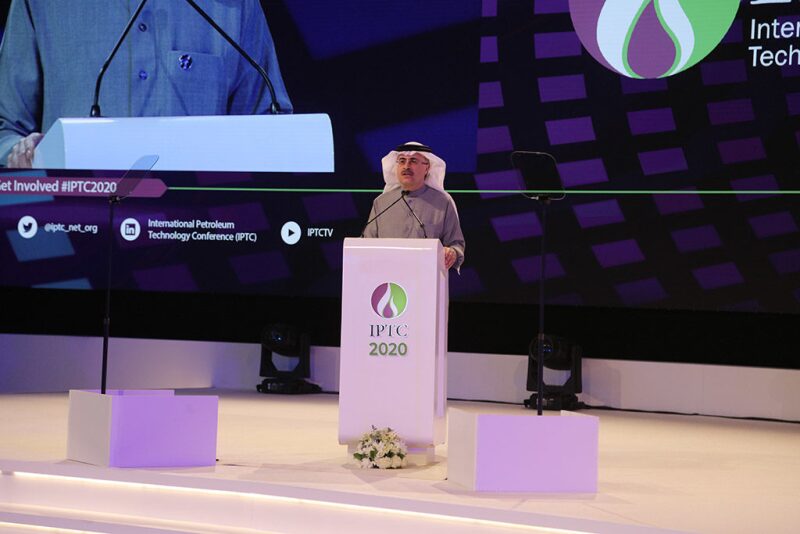JPT interviewed Saudi Aramco President and Chief Executive Officer Amin Nasser during the International Petroleum Technology Conference (IPTC) held 12-15 January in Dammam, Saudi Arabia. He discussed the company’s outlook for the new year and the current state of the oil and gas industry.
Saudi Aramco has recently faced a very low price oil environment, competition from US shale, and a drone and missile attack yet has continued to move forward in spite of this. How has Saudi Aramco remained so resilient?
Saudi Aramco is used to dealing with oil market volatility and effectively responding to unforeseen events. Our production costs are among the lowest in the industry and we remain quite profitable even during market down cycles. We also have a very strong balance sheet, and maintain high financial flexibility.
Similarly, our infrastructure and plants have built-in, yet optimum, flexibility by design. These factors, among others, show our deliberate and proactive focus on resilience.
What is the status of unconventional development in Saudi Arabia? Is this a key emphasis at present?
Saudi Aramco has significant unconventional gas resources, and the key goals of the current efforts in this area are to delineate and commercially prove this large resource base. Of course, profitability and environmental sustainability are always on top of our agenda.
The major focus of the current efforts is on unconventional gas deposits in the Jafurah Basin in eastern Saudi Arabia. Jafurah has a special economic attraction because its gas is also rich in liquids. The purpose of our unconventional gas program is to prepare these resources to complement supplies from our large conventional gas reserves.
How do you assess the global supply/demand balance in 2020?
The oil demand last year was impacted by global economic headwinds. But most analysts expect the situation to significantly improve this year. The International Energy Agency (IEA), for example, is forecasting 1.2 million B/D growth for 2020, which is fairly healthy.
On the supply side, a key contributor to supply growth over recent years has been the production of US shale oil, which appears to be slowing. And the very recent events add complexity to the supply picture. The assessment of the supply-demand balance by various institutions and consultancies varies, while variations also occur during the year owing to seasonal demand factors. So, we will have to watch the situation as the year progresses.
Saudi Aramco has completed its IPO. Were you satisfied with the process and how the situation has progressed?
The company successfully completed its IPO and our shares began trading on the Saudi Stock Exchange on 11 December 2019. The offering was diversified and balanced, and included individuals, banks, pension funds, sovereign wealth funds, mutual funds, endowments, and foundations. And it included both Saudi and foreign institutions. The offering was over-subscribed by more than 4.6 times.

You are a participant in one of the major panel discussions at IPTC about how CEOs view the “new energy era.” What is your key message?
Our industry has played a key role in creating the economic prosperity the world enjoys today. And we will continue to play our part by providing affordable and reliable supplies of energy.
Global energy is undergoing a transformation but I believe that oil and gas will remain a core element of this transition for a long time to come.
Technology is a key instrument that helps us address the future challenges our industry faces, and we rely on IPTC and its constituent societies to continue playing a major role in promoting advanced technology and sharing best practices and experiences, as they have in the past.
What is your assessment of the current political and public discussion on climate change?
Helping to manage climate change while providing affordable energy are our industry’s top priorities. So, our industry and the climate proponents agree as far as lightening the carbon footprint of energy is concerned.
In other words, we are part of the solution, and our goals in protecting the planet and society’s well being are aligned. But to effectively address complex challenges in the way of concurrently meeting society’s climate, energy, and economic goals, we need to adopt well thought out and realistic solutions, as opposed to opting for hasty and emotional responses.
We hope the industry’s sincere efforts to lower the greenhouse-gas footprint of oil and gas will receive broader support also from outside the industry.
As far as we are concerned, I am glad to report that we have among the greenest oil barrels, with the upstream carbon intensity of Saudi Arabia’s oil among the lowest in the world. Similarly, our methane intensity is also among the lowest in the industry, which is significant considering the high potency of methane as a greenhouse gas.
You recently stated that current carbon management strategies “are too narrowly focused.” Can you elaborate on this?
There is a concern that carbon management efforts being pursued across the world are not producing adequate and rapid results. My view is that an important reason for this situation is that the global efforts to reduce greenhouse gas emissions are too narrowly focused.
What I mean is that currently there are two primary areas in which attention is being centered. One is electrification of light-duty passenger vehicles and the other is replacement of fossil fuels in electricity generation. But these efforts together account for only about one-third of the total global greenhouse gas emissions; the remaining two-thirds receive very little attention. In other words, the efforts are very narrowly focused.
In my view, three additional strategies can help significantly. Firstly, the world needs to broaden its focus and pay attention to all economic sectors with large greenhouse emissions. Secondly, most R&D and technology spend currently focuses on renewables and electric vehicles. The research funding should be extended to reducing the carbon footprint of fossil fuels, which dominate global energy and are likely to continue playing an important role in the world energy mix for a long time to come. Reducing their greenhouse-gas footprint would make a much bigger difference. And thirdly, taking advantage of the pioneering circular economy concept would help in leveraging synergies across a wide range of economic sectors emitting greenhouse gases.


